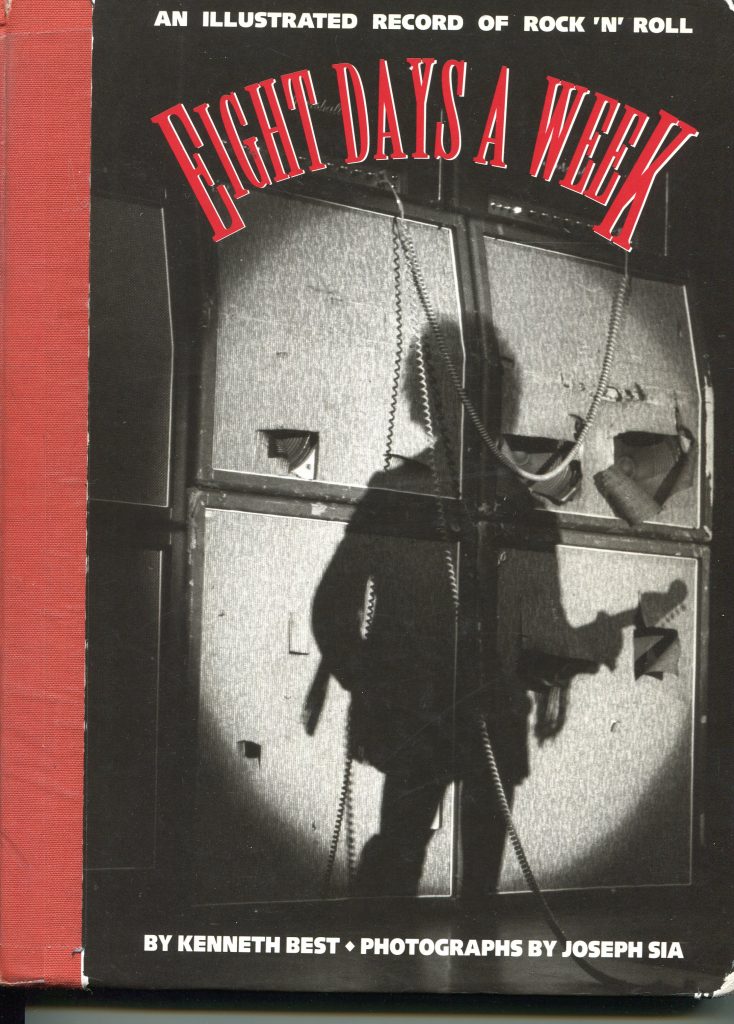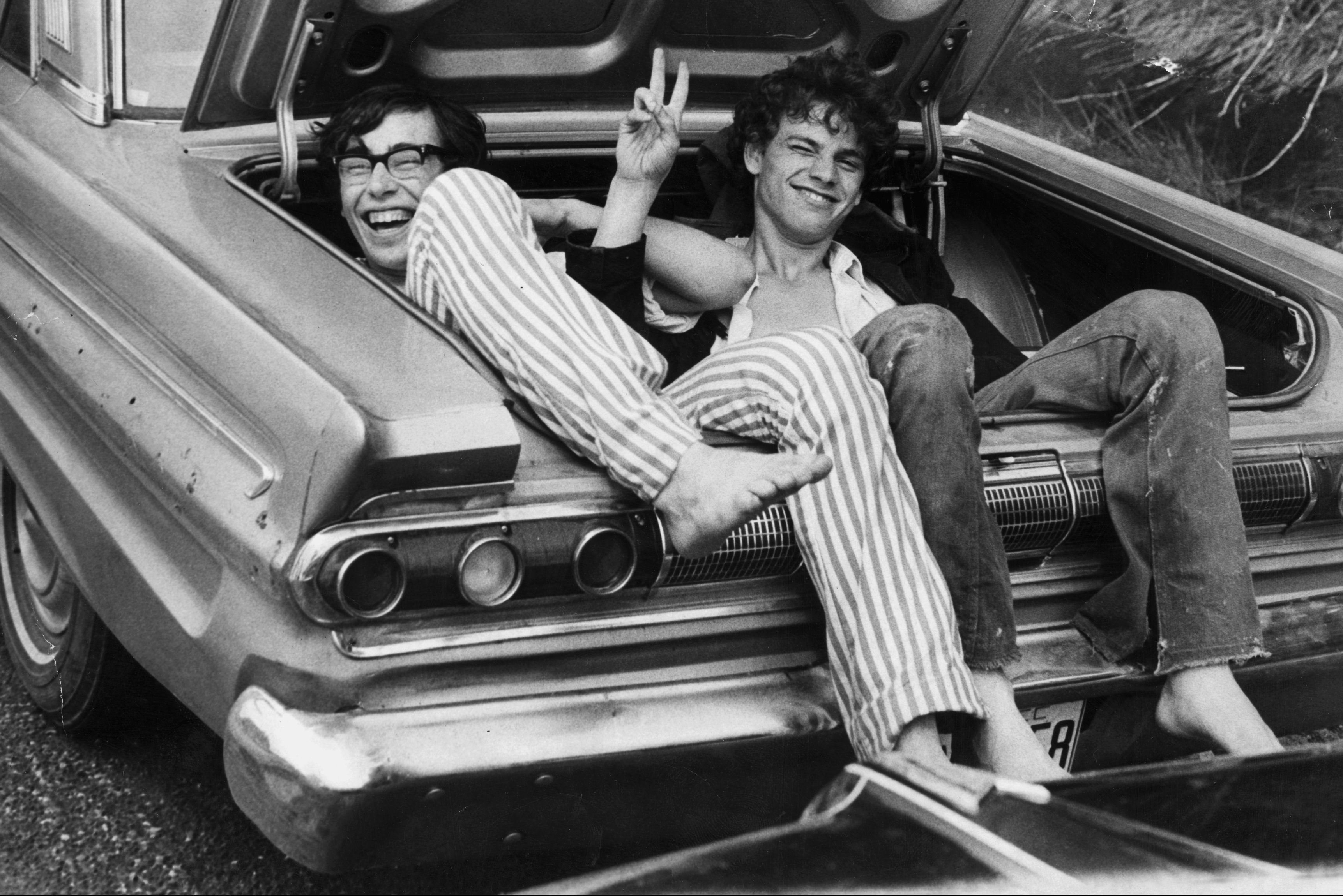[Editor’s Note: The Dodd Center exhibit ‘Day-Glo & Napalm: UConn 1967-1971’ features recollections from University alumni who were here during those turbulent times. In this personal essay, UConn Today writer Ken Best offers his own memories of a rainy weekend that turned out to be a formative experience not only in his life, but in the lives of thousands]
I still describe that weekend in August 1969 as my first and last camping trip, owing to the journey with three friends in my 1959 Chevy Bel Air sedan from just outside of Newark, New Jersey. When we got to the New York State Thruway, we took the advice of the toll collector whom we asked for directions in the days before cell phones or GPS: “Follow the crowd.”
On that warm, rainy Thursday night we followed red taillights of thousands of other cars creeping up the highway for the next five hours, at times pushing the car to save gas. As we appeared to get closer to Bethel, my car seemed to be leading the long line of headlights I saw in the rearview mirror. I had no idea where we were heading. I was just driving on, trying to see through the heavy rainstorm. Without knowing how it happened, we arrived at Max Yasgur’s farm in Bethel, New York, sometime after midnight Friday morning.
It was too muddy and wet to sleep on the ground or start a campfire. We were soaked from the rain – which is how we spent much of the weekend – but managed to get a bit of sleep in the car until the sun came up. In the heat and humidity, we heard the sound of hammers banging on wood in the distance. There were hundreds of sleeping bags on the muddy ground. A parade of people was already moving toward the stage area, so we decided to take our food and drinks and try to get a good seat. We had our $18 three-day tickets, ready to enter the concert gate.
There really wasn’t a gate, but there was an unbelievable sight: a sea of humanity as far as you could see. We managed to take up our place about 100 yards from the stage. It seemed like forever before Richie Havens sat on a stool and started the music.
Over the next 40 or so hours, there was a lot of music, some sun, and a lot of rain and mud. Performances by Sweetwater, Bert Sommer, Ravi Shankar, Melanie, Arlo Guthrie, and Joan Baez went by in a blur. Saturday brought more heat and humidity early on, followed by Quill, Country Joe McDonald and the “Fish Cheer,” Santana, John Sebastian, Keef Hartley, Incredible String Band, and Canned Heat.
Sometime late that night, the skies opened up again. We headed back to the car in a vain attempt to stay dry. When we got back to the car and climbed in, the car started to sink deep into the mud. Thirty minutes of tires spinning and mud flying, as we tried to move the car to a less muddy spot, we started moving — only to realize there was no other place to go. Tired, wet, and covered in muck, we took a vote: Stay, or head back to New Jersey. Garden State Parkway, here we come.
After seeing the news coverage of Woodstock the next morning, which mostly described the mud and mess, I called the Newark News. Yes, I reported, it was a bit inconvenient, but the reporter I spoke with accurately got my review of the music: “It was fantastic.”

More recent reflections I have had about Woodstock made me realize how often it has resurfaced in my work through contact with people who were there, both performers and others connected to the musicians. As a news reporter, I often found new opportunities to write about the performers and their most recent recordings or upcoming performances.
The renowned lighting designer Chip Monck, who split his time between running the lights at Woodstock and making stage announcements, including the famous warning about avoiding the “brown acid,” chatted with me in 1974 about his role as host of “Speakeasy,” one of the early rock television talk shows, where the house pianist was a young musician who soon would become nationally known – Billy Joel. Three years later, I spoke with Arlo Guthrie during a late post-concert dinner on Eighth Avenue in New York City. Around that same time I covered a Grateful Dead news conference when the group announced they would go to Egypt and perform at the Pyramids. Joni Mitchell wrote the song “Woodstock,” but was not a performer; however, I interviewed her during Bob Dylan’s 1976 Rolling Thunder Tour, when the ever-changing cast of musicians stopped at the prison in New Jersey where Rubin “Hurricane” Carter was incarcerated and the song “Hurricane” was on Dylan’s most recent album.
However, my closest personal association with a Woodstock veteran was the late Joe Sia, a Fairfield County native who was one of the early rock ‘n’ roll photographers. Sia traveled around Connecticut and into New York, New Jersey, and Rhode Island in the days when photographers had free rein. His photos from the Newport Jazz and Folk Festivals earned him an assignment from Rolling Stone magazine to go onstage and backstage at Woodstock. His 1970 photo compilation Woodstock 69: Summer Pop Festivals went into three printings.
I met Joe in the mid-1980s, hiring him to take sports photos when I worked at the University of Bridgeport. He would stop by to talk sports, but one day he asked about getting access to a concert on campus and told me about his history taking concert photos and at Woodstock. It did not take long for us to add music to our regular chats.
When I wrote my 1992 book, Eight Days a Week: An Illustrated Record of Rock ‘n’ Roll (Pomegranate), I spoke to the publisher about exclusively using Joe’s photos for the book. We spent a couple of hours one night with page proofs deciding on the musician to use on the two-page format layout of the book, going through his pile of contact sheets from dozens of concerts. Three of his photos in the book were from Woodstock performances: Grace Slick of Jefferson Airplane, Pete Townshend of The Who, and a view of the crowd from the stage. The cover of the book was his most famous image known as “The Shadow,” a 1968 photo taken at Woolsey Hall at Yale of Jimi Hendrix’s shadow in a spotlight against four giant amplifiers.
In recent years, I have talked about Woodstock every August on the radio — while doing a program on the community radio station WPKN in Bridgeport, where I had a presence for more than 15 years, and more recently on WHUS in Storrs, where I spend the summer doing a weekly show while UConn students are away. I play the original vinyl double LP from 1970, along with remastered compact disc sets that include additional tracks. I presumed it might be the only time I would think much more about Woodstock this summer, until I learned about a new exhibit at the Archives Gallery at the UConn Library.
“Day-Glo & Napalm: UConn 1967-1971” is a collection of memorabilia, documents, and information provided by alumni reflecting on their college days in Storrs. Classic rock albums are included in the exhibition that continues until Oct. 25, along with posters from that time. Included are two posters from 1969 that have the neck of a guitar with a dove sitting on top declaring “An Aquarian Exposition in White Lake, N.Y.: 3 Days of Peace & Music.” It appears that my days of reflecting are not yet over.



